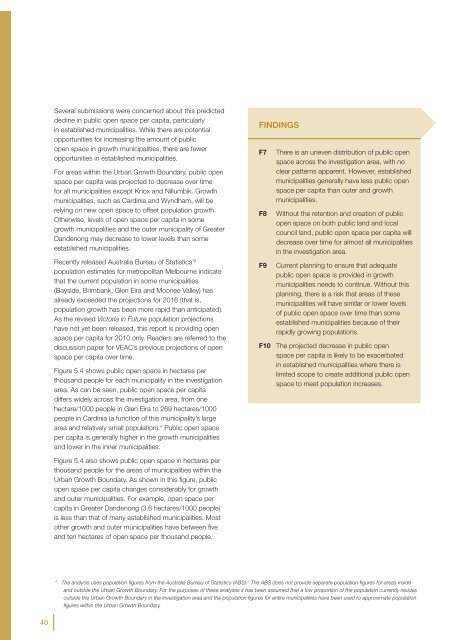Metropolitan Melbourne Investigation - Victorian Environmental ...
Metropolitan Melbourne Investigation - Victorian Environmental ...
Metropolitan Melbourne Investigation - Victorian Environmental ...
Create successful ePaper yourself
Turn your PDF publications into a flip-book with our unique Google optimized e-Paper software.
Several submissions were concerned about this predicted<br />
decline in public open space per capita, particularly<br />
in established municipalities. While there are potential<br />
opportunities for increasing the amount of public<br />
open space in growth municipalities, there are fewer<br />
opportunities in established municipalities.<br />
For areas within the Urban Growth Boundary, public open<br />
space per capita was projected to decrease over time<br />
for all municipalities except Knox and Nillumbik. Growth<br />
municipalities, such as Cardinia and Wyndham, will be<br />
relying on new open space to offset population growth.<br />
Otherwise, levels of open space per capita in some<br />
growth municipalities and the outer municipality of Greater<br />
Dandenong may decrease to lower levels than some<br />
established municipalities.<br />
Recently released Australia Bureau of Statistics’ 2<br />
population estimates for metropolitan <strong>Melbourne</strong> indicate<br />
that the current population in some municipalities<br />
(Bayside, Brimbank, Glen Eira and Moonee Valley) has<br />
already exceeded the projections for 2016 (that is,<br />
population growth has been more rapid than anticipated).<br />
As the revised Victoria in Future population projections<br />
have not yet been released, this report is providing open<br />
space per capita for 2010 only. Readers are referred to the<br />
discussion paper for VEAC’s previous projections of open<br />
space per capita over time.<br />
Figure 5.4 shows public open space in hectares per<br />
thousand people for each municipality in the investigation<br />
area. As can be seen, public open space per capita<br />
differs widely across the investigation area, from one<br />
hectare/1000 people in Glen Eira to 269 hectares/1000<br />
people in Cardinia (a function of this municipality’s large<br />
area and relatively small population).* Public open space<br />
per capita is generally higher in the growth municipalities<br />
and lower in the inner municipalities.<br />
FINDINGS<br />
F7<br />
F8<br />
F9<br />
There is an uneven distribution of public open<br />
space across the investigation area, with no<br />
clear patterns apparent. However, established<br />
municipalities generally have less public open<br />
space per capita than outer and growth<br />
municipalities.<br />
Without the retention and creation of public<br />
open space on both public land and local<br />
council land, public open space per capita will<br />
decrease over time for almost all municipalities<br />
in the investigation area.<br />
Current planning to ensure that adequate<br />
public open space is provided in growth<br />
municipalities needs to continue. Without this<br />
planning, there is a risk that areas of these<br />
municipalities will have similar or lower levels<br />
of public open space over time than some<br />
established municipalities because of their<br />
rapidly growing populations.<br />
F10 The projected decrease in public open<br />
space per capita is likely to be exacerbated<br />
in established municipalities where there is<br />
limited scope to create additional public open<br />
space to meet population increases.<br />
Figure 5.4 also shows public open space in hectares per<br />
thousand people for the areas of municipalities within the<br />
Urban Growth Boundary. As shown in this figure, public<br />
open space per capita changes considerably for growth<br />
and outer municipalities. For example, open space per<br />
capita in Greater Dandenong (3.6 hectares/1000 people)<br />
is less than that of many established municipalities. Most<br />
other growth and outer municipalities have between five<br />
and ten hectares of open space per thousand people.<br />
* The analysis uses population figures from the Australia Bureau of Statistics (ABS). 2 The ABS does not provide separate population figures for areas inside<br />
and outside the Urban Growth Boundary. For the purposes of these analyses it has been assumed that a low proportion of the population currently resides<br />
outside the Urban Growth Boundary in the investigation area and the population figures for entire municipalities have been used to approximate population<br />
figures within the Urban Growth Boundary.<br />
40
















